|
Travel anywhere in the world in less than two hours - or even into
space. That's the promise of HyperSoar - The Space Hopping Hyperplane.
by Ann Parker
From the doodlings of Leonardo da Vinci and the penned fantasies
of Jules Verne to the tangible accomplishments of the Wright brothers
and other aviation pioneers, mechanized flight has captured the
imagination of humanity through the centuries. Even today, with
atmospheric and space flight a reality, there are still aviation
realms to dream about and conquer.
Hypersonic flight at speeds 5 to 12 times the speed of sound (Mach
5 to Mach 12) is one such area of interest to the commercial and
defense communities. At Lawrence Livermore National Laboratory,
aerospace engineer Preston Carter has invented a concept for a next-generation
hypersonic aircraft, dubbed HyperSoar, that would fly efficiently,
economically and cleanly.
Flying at Mach 10 (3 kilometers per second), HyperSoar could reach
any point on the globe within two hours. For comparison, the fastest
military plane, the SR-71, flies between Mach 3 and Mach 4, while
the commercial Concorde reaches only Mach 2. HyperSoar would also
have twice the fuel efficiency of commercial airliners, be three
to five times more efficient in putting satellites in space than
today's launch systems, and use liquid hydrogen fuel, which produces
simple water vapor when burned.
HyperSoar - a concept-development project funded through Livermore's
Physics Directorate and the Laboratory Directed Research and Development
Program - could transport people or cargo, strike enemy targets,
or help put satellites into space.
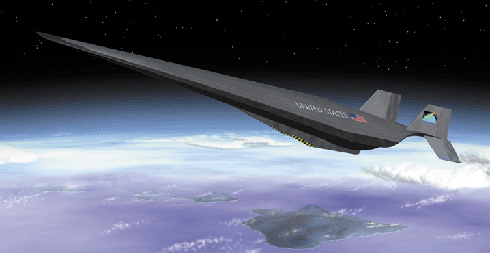
Lawrence
Livermore National Laboratory
HyperSoar
over Hawaii, on its 72-minute flight from Los Angeles to Tokyo
|
"The fact that HyperSoar has many potential uses is key," says
Carter. "Developing an entirely new aircraft is expensive. However,
if there is a large market for such an aircraft, the cost per plane
goes down. It's like the difference between a 747 and the Stealth
bomber. There are hundreds of Boeing 747s being used by commercial
airline companies, airfreight companies, and so on. But the only
market for the Stealth is the military, which only needs a few.
That's why you'll never see a Stealth being built for much less
than they cost today."
Skipping on the atmosphere
A 25-meter-long HyperSoar aircraft (about as long as the wingspan
of a large business jet) could make a conventional takeoff from
a standard runway. Using special combined-cycle engines that are
air-breathing but based on rocket technology, it would ascend to
40 kilometers. Here - at the outer limit of Earth's atmosphere -
its engines would be turned off. HyperSoar would then coast up to
a high point of 60 kilometers, before beginning to fall back down
to about 35 kilometers, well inside the upper levels of the atmosphere.
As the aircraft descends into denser air, it would be pushed up
by the increased aerodynamic lift. The engines then fire briefly,
propelling the plane back into space. Outside the atmosphere, the
engines shut off and the process repeats. In this way, HyperSoar
would skip off the top layer of the atmosphere every two or so minutes,
like a flat rock skittering in slow motion across the surface of
a pond.
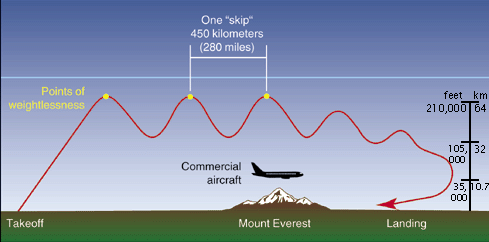
Lawrence
Livermore National Laboratory
HyperSoar
skips in and out of the atmosphere, giving a ride like a slow-motion
swing
|
Passengers would
feel 1.5 times the force of gravity at the bottom of each skip, and
weightlessness out in space. The experience would be comparable to
being on a swing, although HyperSoar's motion would be a hundred times
slower.
Including the ascent and descent portions of a flight, a trip from
Chicago to Tokyo (10,123 kilometers) would involve about 18 skips
and 72 minutes. To travel from Los Angeles to New York (3,978 kilometers)
would involve about 5 skips and take only 35 minutes. (Both flights
require a total of about 2,450 kilometers and 27 minutes for take
off and landing.)
By popping regularly out of the atmosphere and using the engines
intermittently, HyperSoar would use less fuel and also solve a critical
problem that plagues other hypersonic aircraft designs - overheating.
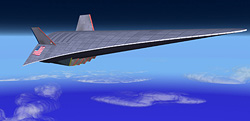
Lawrence
Livermore National Laboratory
Travel
at 12 times the speed of sound will be possible
|
Beating the heat
Any object speeding through the atmosphere - airplane, spacecraft,
meteorite - will compress and heat the air in front of it. This
heat is inevitably absorbed by the surface of the object.
"Heat buildup just kills most designs for hypersonic aircraft,"
explains Carter. "The hotter the craft gets, the more material engineers
add to the airframe to strengthen and shield it. Also, most other
hypersonic concepts have trajectories that are strictly atmospheric,
and the only way to get rid of the heat is to dump it into the fuel
and then burn the fuel in the engines. The problem is, the faster
you fly, the more fuel you must carry as a heat sink. Eventually,
you end up carrying a significant amount of fuel just as a heat
sink, and the engines end up running fuel-rich, that is, burning
up more fuel than they really need. That's wasteful in and of itself.
Also, more material and more fuel translate to more weight. After
a while, the aircraft can no longer carry a decent cargo."
Because HyperSoar spends nearly two-thirds of its time out of the
atmosphere, it can radiate the heat into space. Carter and colleagues
at the University of Maryland have analyzed HyperSoar, compared
it to other concepts, and found that - thanks to its trajectory
and shape - HyperSoar has less heat load on its airframe and consumes
less fuel.
From express mail to satellites
"The way HyperSoar blends flight and space access is revolutionary,
opening up a world of potential applications," says Carter. Possibilities
include using HyperSoar as a freighter, military aircraft, low-cost
launcher, and, eventually, a passenger aircraft. According to Carter,
HyperSoar would be capable of carrying more weight over longer distances
than other planes of similar size and mass.
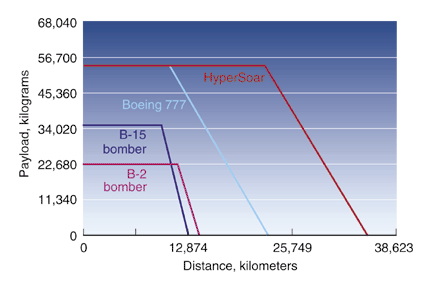
Lawrence
Livermore National Laboratory
HyperSoar
can carry a greater weight over a longer distance than similar-sized
planes
|
As a freighter,
it could make four round-trips to Tokyo daily, as compared to one
or less for today's aircraft. This speed would be a boon to the
$4-billion-per-year commercial intercontinental package delivery
market. "The speed of today's aircraft has limited the growth of
this market," says Carter. "The express delivery industry requires
central intracontinental hubs that are about two hours' flying time
apart. Current technology allows express mail, for instance, to
move between these hubs in close to that time. Now, imagine the
possibilities if you could fly between Memphis and Singapore in
close to two hours." Carter estimates that a HyperSoar aircraft
flying express mail between Los Angeles and Tokyo could generate
ten times the daily revenue of a similar-size subsonic cargo plane.
As a military
aircraft, a HyperSoar bomber the size of an F-22 could take off
from the U.S. and deliver its payload from an altitude and at a
speed that would defy all current defensive measures. It could then
return directly to the continental U.S. without refueling and without
the need to land at forward bases on foreign soil.
For reaching space, HyperSoar could be employed as the first stage
of a two-stage-to-orbit launch system. At the high point of its
skip, HyperSoar would eject an upper-stage vehicle and its payload
into low-Earth orbit. For a given takeoff weight, this approach
would deliver approximately twice the payload to orbit as any of
today's expendable rockets.
A larger HyperSoar vehicle, the size of a Boeing 777 for example,
could handle a 13.7 metric ton payload in addition to the weight
of a typical second-stage launcher. At take-off, this version of
the HyperSoar would weigh 255 metric tons, about half as much as
the largest Ariane 4 rocket - but it would carry about 40 percent
more payload. Because most satellites are smaller than this, in
reality the HyperSoar vehicles will not need to be built as large
vehicles but rather as smaller, less expensive ones.
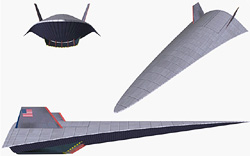
Lawrence
Livermore National Laboratory
$500
million is needed to turn the 'paper plane' into a prototype
|
Flying the paper plane
Even though HyperSoar is still in the "paper airplane" stage, it
has garnered interest from organizations as diverse as Federal Express
and the U.S. Air Force Strategic Air Command. HyperSoar has appeared
in Jane's Defence Weekly, Aviation Week and Space Technology, Scholastic's
Weekly Reader, and daily papers from the Los Angeles Times to the
Washington Times to local newspapers such as the Valley Times.
Passenger flight would be one of the last applications to become
reality, but it is the one that the media and the public are most
interested in. "The public gets very excited about space and air
travel," said Carter. "To the general public, HyperSoar looks doable.
The technology is nearly there, the concept is proven on paper.
The thing now is to make it economically feasible to the defense
and commercial communities so HyperSoar can get the funding it needs
to take the next step in development."
Carter estimates that about $500 million would be needed to develop
the technologies needed, and to build and test a 16-meter-long flyable
unmanned prototype. Lawrence Livermore is positioned to help bring
HyperSoar into reality because of its expertise in thermal protection
materials, large-scale computational fluid dynamics, ultrahigh pressure
testing design, and modeling the environmental effects of high-speed
supersonic aircraft.
The question of funding aside, the day when passengers can hop
a HyperSoar to London is still a way off.
"When most people hear about HyperSoar," Carter adds, "they immediately
think big - building big airplanes to carry lots of passengers or
cargo. But that's not economically feasible. I propose building
small airplanes to justify the market and then building up from
there, according to the need. That's how all the different flight
technologies - airplanes, jets, helicopters - got started. It's
the way that fledgling technologies like HyperSoar take wing."
|
